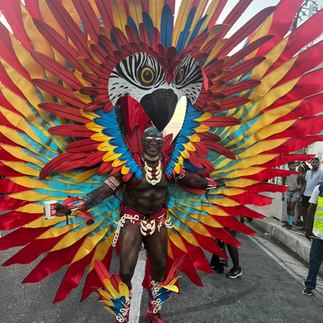Reconnecting With The Freedom Of Dance At Trinidad Carnival
- Ken_Ken

- Feb 25, 2024
- 4 min read
Carnival was an integral part of my childhood in Antigua. As a child I looked forward to the annual parades of color, music and dance. The joy, revelry and community everyone had at carnival was something I distinctly remember. So too were the shapes, figures and characters on display. The costumes that represented African Folklore always stood out to me because they often scared me. That fear is what makes them quite vivid in my memory. The moko jumbie stilt walkers in their flowing costumes were always fascinating. The name alone which incorporates the word “jumbie” brought me so much curiosity as a child. In Antigua and throughout the english speaking Caribbean, a jumbie is the spirit of a dead person. The 10 year old me thought the moko jumbies were jumbies walking around on display for everyone to see. The Jambull was another African Caribbean character that brought me so much fear. It was a character dressed in crocus bags and dried banana leaves wearing a mask and fitted with bull horns. The jambull would run through the crowds gathered for carnival pushing them out of the way, as if it wanted to kill them. For me the jambull was a scary creature, one that I never wanted to look at but couldn’t resist staring at in curiosity. In addition to the folklore characters on display at carnival, it was the display of color and dance that also stuck with me. The colorful and elaborate costumes, and the freeform dancing that involved various types of rhythmic jumping, whining (circular movement of the hips) and footwork mesmerized me. These are the vivid memories of carnival that I carry with me. Through the years the festivals have evolved and many of those traditional aspects of carnival have slowly faded away replaced by the party culture of carnival.
I’ve long wanted to reconnect with carnival, not necessarily to relive the memories of my childhood, but to rediscover what is carnival. So when the invitation came from my dear friend Hakim to join him for Trinidad’s carnival, I jumped at the opportunity. What better way to experience carnival than with friends who embody and live the carnival culture. Trinidad’s carnival is the largest in the English speaking Caribbean and would provide the perfect opportunity to experience carnival in all of its glory. I came with no expectations, except to be present in the moment and soak it in. It was my first time in Trinidad which was always on my list of places to discover because of the African and Indian cultures blending together.
My rediscovery lead me to 2 days of literally dancing the day away. On carnival Monday and Tuesday, the 2 days known for their ritual of dancing in the streets, I was shocked at the length of time spent dancing. Some 13 hours on Monday and 16 hours on Tuesday! And while that sounds brutal (it is!) it was also deeply exhilarating. The street dancing ritual commenced Monday February 12 at 4am with Jouvert, a street bacchanal notorious for its in your face bluntness of living freely. Jouvert is where you dance your troubles away covered in paint, mud, powder and sweat. There was something deeply liberating about letting it all go, getting covered in paint and mud without the worry of being “presentable”. Of being with friends dancing your way through the streets of Port of Spain in the early morning, sweating, laughing, whining, and singing at the top of your lungs. Jouvert is one of those carnival experiences that sounds unpleasant until you experience it. It was in this moment covered in paint, surrounded by friends and fellow revelers, looking at the smiles, the freedom everyone had in their movements, and the pure ecstasy on everyone’s face that I remembered what dance meant to me. So often dance can sometimes feel like it’s a contest of who is the most technically adept at executing the latest dances or can master specific styles. But dance Is not just about technique and form, and battles, and stage presentations or complex choreographies. Yes all those are part of the beautiful art form of dance, but we also cannot forget the communal purpose of dance. At its core dance is democratic, it is freedom, it is joy, it is healing, it is cultural expression. Dance connects people together, and seeing the thousands of people dancing at carnival, I was pleasantly reminded of the power of dance. Carnival reconnected me to dance in its purest and most natural form: the ability to just move and feel joy.
For 2 days, I experienced this joy of collective movement, where everyone was an expert regardless of training or expertise. Where one signature movement—the whine (circular rotation of the hips) is personalized, each dancer executing their own whine. As we danced we felt connected, free of judgement, collectively being the spotlight. It was all of us swaying and sweating together that created the carnival experience. It is the community bonding together through dance that makes carnival Monday and Tuesday so euphoric and memorable. And it was the perfect reminder I needed to what dance meant for me. That is community, people connection, joy, but most of all the freedom to just move however you like.
The colors of carnival costumes are always memorable. A few shots of fellow masqueraders who palyed masson Carnival Tuesday, February 13th, with Lost Tribe band, in 2024 (Trinidad)
The Mokojumbies were everywhere
The energy and happiness at carnival is euphoric
Carnival Monday was absolutely exhilarating
And of course I cannot forget the paint, mud, sweat and powder of Jouvert










































Comments